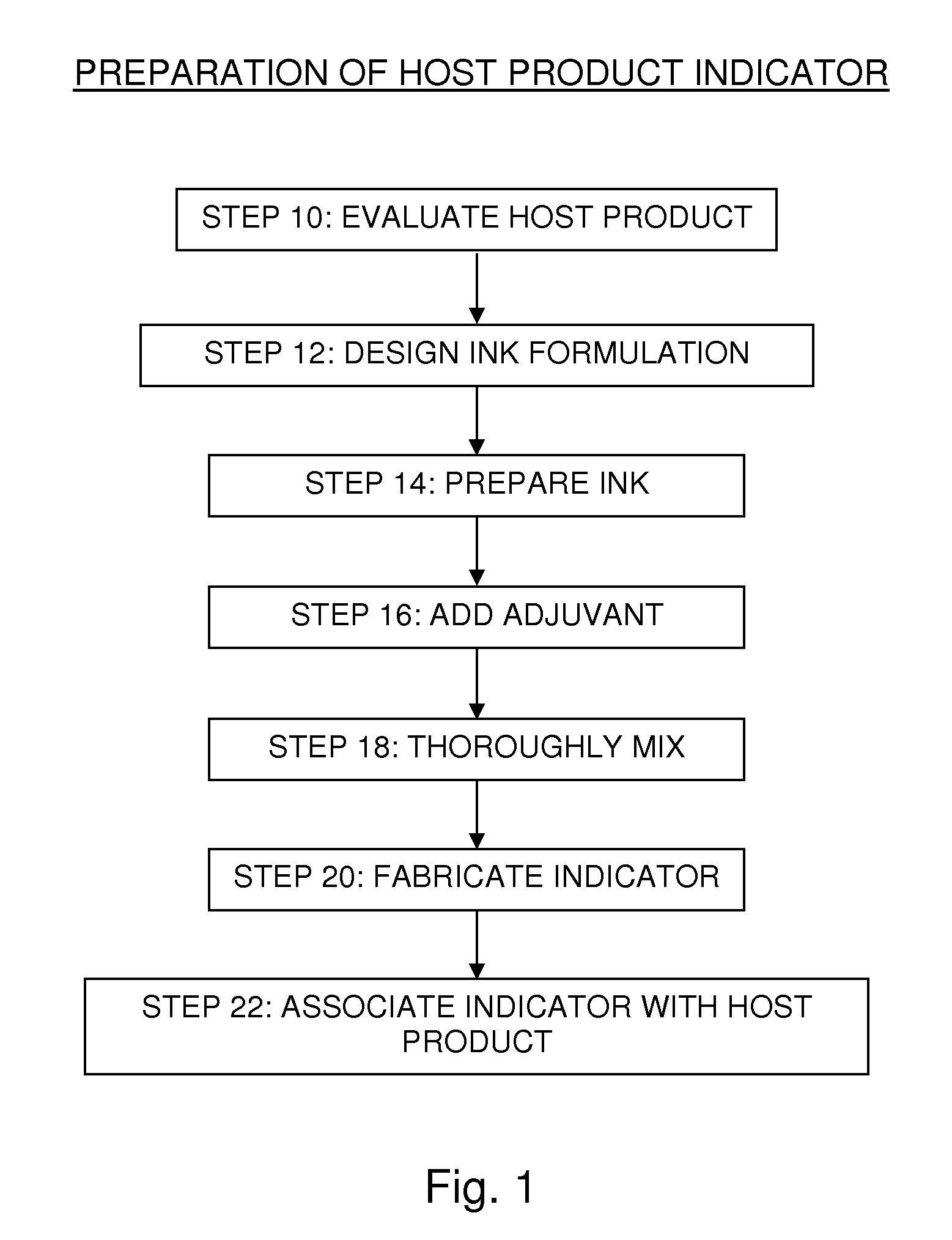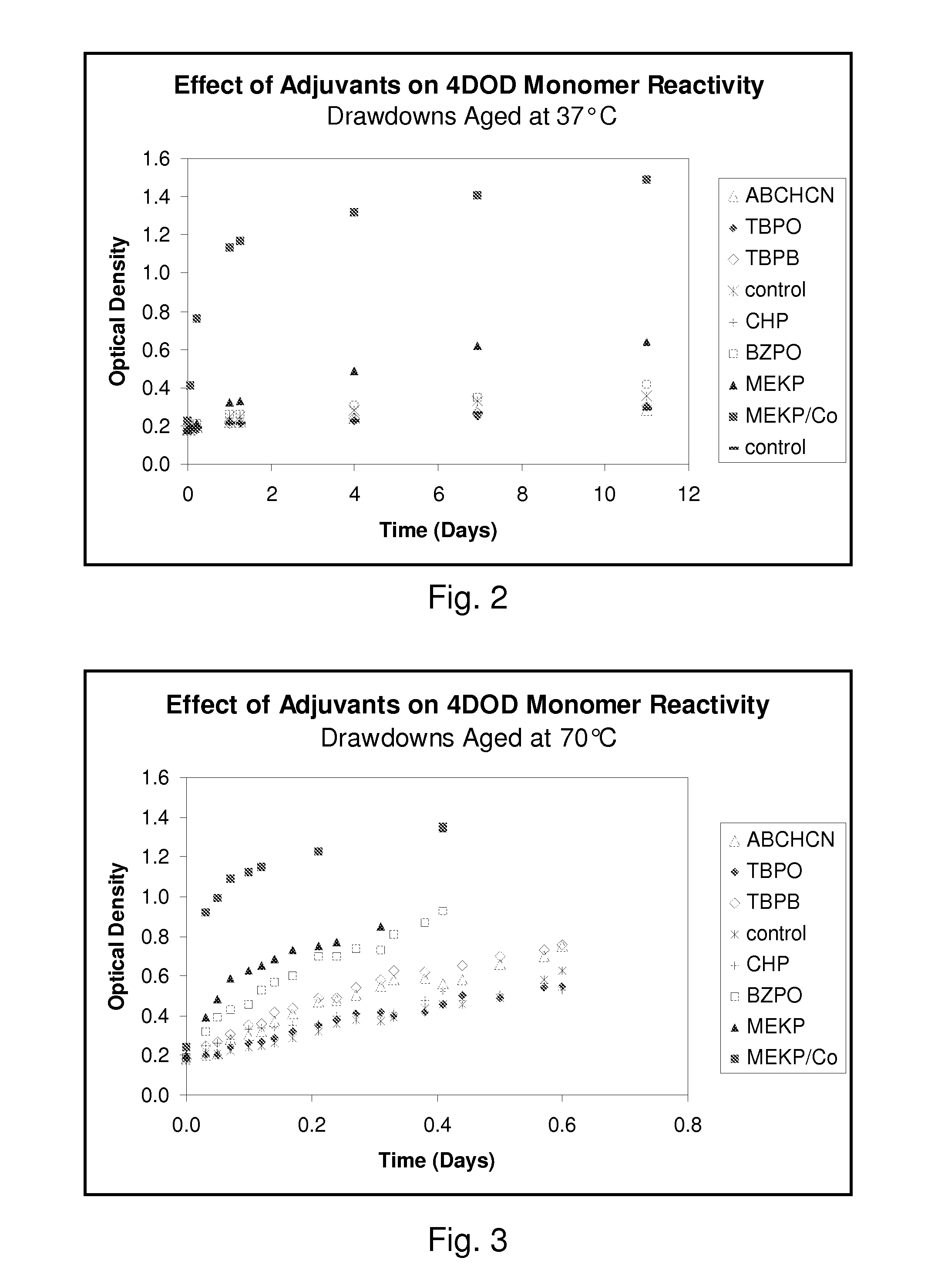Adjuvant-mediated reactivity enhancement of polymerizable polyacetylenic materials
- Summary
- Abstract
- Description
- Claims
- Application Information
AI Technical Summary
Benefits of technology
Problems solved by technology
Method used
Image
Examples
example 1
Preparation of Initiator-Containing Indicator Ink From Thermally Insensitive Polymerizable Diacetylenic Monomer
[0214]a) Preparation of Diacetylenic Monomer. To serve as indicator agent, a thermally insensitive polymerizable diacetylenic monomer, namely 5,7-dodecadiyn-1,12 diol bis (n-octadecyl urethane, is synthesized in sufficient quantity for preparation of a master batch of ink, by the method described in Yee U.S. Pat. No. 4,215,208 at column 17, lines 47-65.
[0215]The resultant white powder has little ambient temperature thermal reactivity. If more reactive diacetylenic monomers, that are sensitive to ambient temperatures, are employed they can be stored at lower temperatures where they will not polymerize, for example at about −30° C. or below.
[0216]b) Ink Preparation. A master batch of 5,7-dodecadiyn-1,12 diol bis (n-octadecyl urethane, “4DOD”, ink is prepared from the following ingredients:
[0217]9.8 weight percent of 5,7-dodecadiyn-1,12 diol bis (n-octadecyl urethane, “4DOD” p...
experiment 1
tivity of 4DOD at 37° C.
[0236]Drawdowns are prepared by coating ink samples prepared as described in Example 1 on to opaque white strips of 7-mil thick polyethylene terephthalate (“PET”) film using a 1.5 mil Bird applicator. Two drawdowns are prepared for the control, Sample 1. The drawdowns are aged at a controlled temperature of 37° C. and the effect of the adjuvants on ink thermoreactivity is studied by measuring the change in optical density (“OD”) with time of each sample. Optical density measurements were made at a number of intervals over a period of 11 days using an X-Rite model 404 portable color reflection densitometer (X-Rite Inc.) in cyan mode. Some results obtainable from this thermal reactivity experiment are set forth in Table 1 below and are shown graphically in FIG. 2.
[0237]The optical density “OD” described below is obtained as the log to the base 10 of the percentage of incident light reflected, (with the sign adjusted) according to the formula
OD=−log10(R)
[0238]wh...
experiment 2
tivity of 4DOD at 70° C.
[0246]Experiment 1 is repeated with the difference that the drawdowns are aged at a controlled temperature of 70° C. Some results obtainable from this thermal reactivity experiment are set forth in Table 2, below and are shown graphically in FIG. 3.
TABLE 2Thermal Reactivity Results for 4DOD at 70° C.8Time12341 (repeat)567MEKP / (days)4DODABCHCNTBPOTBPB4DODCHPBZPOMEKPCo0.000.170.180.180.180.180.210.190.210.240.030.200.200.200.250.210.250.320.390.920.050.210.210.200.270.210.260.390.480.990.070.230.280.240.310.220.280.430.591.090.100.250.300.260.350.240.330.460.631.120.120.280.320.270.360.250.340.530.651.150.140.290.370.290.420.260.340.570.69—0.170.300.410.320.440.290.350.600.73—0.210.320.470.350.490.320.360.700.751.230.240.360.480.380.490.360.400.700.77—0.270.380.500.410.540.380.410.74——0.310.370.550.420.580.370.400.730.85—0.330.420.580.400.630.390.420.81——0.380.430.590.420.620.440.480.87——0.410.440.560.46—0.460.520.931.351.350.440.480.580.500.650.460.48———0.500....
PUM
| Property | Measurement | Unit |
|---|---|---|
| Temperature | aaaaa | aaaaa |
| Temperature | aaaaa | aaaaa |
| Temperature | aaaaa | aaaaa |
Abstract
Description
Claims
Application Information
 Login to View More
Login to View More - R&D
- Intellectual Property
- Life Sciences
- Materials
- Tech Scout
- Unparalleled Data Quality
- Higher Quality Content
- 60% Fewer Hallucinations
Browse by: Latest US Patents, China's latest patents, Technical Efficacy Thesaurus, Application Domain, Technology Topic, Popular Technical Reports.
© 2025 PatSnap. All rights reserved.Legal|Privacy policy|Modern Slavery Act Transparency Statement|Sitemap|About US| Contact US: help@patsnap.com



